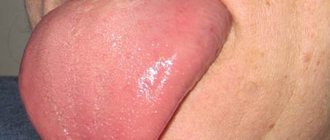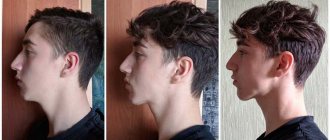The division of the tongue (snake, forked tongue) is called splitting (from the English split - “to separate”). This is an extreme type of body modification, which involves surgically dividing the organ into two parts along the midline, from tip to middle. The purpose of this procedure is self-expression, emphasizing one’s own individuality. Some people resort to this type of body fashion to match fashion and youth trends. Another meaning of splitting is to increase sensuality and expand opportunities in intimate relationships. Kissing and caresses with a forked tongue evoke more vivid sensual sensations in your partner. Most people who decide to split can control the two halves of the tongue separately using muscles.
Features and Precautions
Split tongue is a more complex type of body modification than puncture (piercing). It requires the participation of a qualified performer, preferably with medical, and even better, surgical education. It is not recommended to perform the manipulation at home or in “handicraft” conditions; this task should also not be entrusted to a first-year medical student. To avoid complications, sterile conditions, special drugs (anaesthetics, hemostatic agents) and professional surgical instruments are required. At home, these requirements are difficult to meet.
Before undergoing the splitting procedure, it is necessary to study the contraindications. They are as follows:
- Allergy to anesthetics is very dangerous, because... During the operation, anaphylactic shock and Quincke's edema may develop (an increase in the volume of the larynx and, as a result, the inability to breathe);
- problems with blood clotting, a tendency to bleed, taking anticoagulants (even simple aspirin) can lead to blood loss and require more complex manipulations;
- high temperature, fever and other acute conditions are a general contraindication to any interventions, including surgical division of an organ;
- Oncological diseases are also a general absolute contraindication.
Complications and health consequences should also be kept in mind. If the procedure is performed by an unqualified doctor, this can lead to unfavorable developments:
- infection and tissue necrosis;
- nerve damage.
While the infection is a reversible process that can be stopped with antibiotics, damage to the nerves responsible for sensation and movement is difficult to reverse. This will require more complex and expensive surgery, but a positive outcome is not guaranteed.
When the halves heal, the person still expects specific consequences:
- poor diction (usually it becomes more difficult for a person to pronounce the sounds D, T, R and other fricatives);
- increased hissing and whistling sounds;
- spitting saliva while speaking.
If the procedure is performed professionally, then the taste of food does not change during bifurcation.
Split language: reviews
In various modern subcultures, which include punks, bodysuits, emo and others, having a forked tongue is considered an indicator of “coolness”, distinguishing a person from the mass of ordinary people. Split tongue (photo) is popular among young people under 25 years of age. Sometimes people who do not belong to any of the newfangled trends decide to make such a modification, but only want to emphasize their unusual individuality in the intimate sphere.
Reviews of bilingual tongue surgery vary significantly. For some, wounds heal faster, for others it is extremely slow and painful. In addition, the attitude towards a person with such an unusual body part in society is ambiguous. As numerous surveys show, most people find splitting unpleasant or outright disgusting. But as you know, taste and color...
Before deciding on such a modification, you need to know that if a person wants to return his “integral” language, this may turn out to be almost impossible. From a medical point of view, such an operation will be too long and painful, and besides, it will not be possible to fully restore the previous length, mobility and agility, so quite serious problems with speech may appear.
How is splitting done?
Division into two halves is a surgical operation, it is performed under local anesthesia using a scalpel. Technically, this is a simple operation, although the preparation for the operation and the method of making the incision depend on the experience and chosen technique of the specialist. The standard bifurcation steps are:
- Before surgery, the patient is recommended to brush his teeth and remove white plaque with a brush, then rinse his mouth with an antiseptic solution;
- the doctor injects an anesthetic directly into the tongue;
- With a special surgical instrument, the master clamps the tongue in the middle and leaves the clamp for 30-45 minutes to stop the blood supply at the incision site;
- Using a sterile scalpel, the doctor cuts the tongue into two parts;
- A piece of gauze with an antiseptic is placed between the halves of the fabric.
This algorithm may vary depending on the skill and experience of the performer. Applying a clamp helps keep blood loss to a minimum. Other specialists, in addition to the incision, sutured the two halves to stop bleeding and reduce the risk of tissue infection.
In rare cases, splitting can be performed with a laser, but for this you need to find a specialized medical institution that provides this type of service. In practice, it is very difficult to find, so in most cases, bifurcation is performed surgically.
What happens if tongue frenuloplasty is not performed in children?
An abnormality of the frenulum of the tongue in children provokes the following serious consequences.
- Due to a violation of the sucking regime in infancy, the child may not receive enough nutrition and, as a result, lag behind in development.
- Children with tongue frenulum abnormalities may never learn to pronounce some sounds.
- Incorrect placement of the frenulum leads to underdevelopment of the lower jaw, resulting in the formation of an incorrect bite.
If pathology of the frenulum of the tongue has been identified in a newborn, it can be easily corrected by making an incision with a laser. At this age, you won't even need stitches. With age, the structure of the frenulum becomes more complex, new vessels appear in it, so plastic surgery of the frenulum in preschool and school-age children turns into a full-fledged surgical operation. Therefore, it is best to do it at the age of 5-6 years, when the child’s milk teeth are replaced by permanent ones.
Care, healing time and possible complications
The most difficult period after cutting is the first few days. At this time, a natural reaction of the body is observed - inflammation and swelling. The tongue will hurt and increase in size, making it impossible to speak and eat normally. Within 1-3 days, body temperature may increase - this is a normal phenomenon that can be controlled with antipyretic or anti-inflammatory drugs.
During the first week after the incision, you will have to eat pureed or liquid food. Sour, salty foods (marinades, sauces, tomato juice), spices and other foods that cause irritation will have to be excluded from the diet. After each meal, you should rinse your mouth with an antiseptic solution without alcohol.
To ensure healing occurs faster and the halves do not grow back together, it is necessary to use a special homeostatic sponge, which must be placed between the two parts and changed every 4 hours.
If all recommendations are followed correctly, healing occurs without complications within 1.5-2 months.
Progress of the operation
It is absolutely impossible to do a split on your own, since there are 2 large arteries . If you hit one of them, it can end in great blood loss and unpleasant consequences. This work should be performed by an experienced craftsman in a special salon.
The operation begins with the depth of the incision being discussed with the master . A line is drawn, the tongue is disinfected and cut, most often to the middle. The separated edges are sewn up with threads. Previously, the incision site was cauterized, but this method is outdated, as it is considered more painful, and the result is less aesthetic. After stitching, the edges are tightened faster and more neatly. laser tongue separation , which is even simpler than the previous ones.
The split is done under local anesthesia using an anesthetic injection. The operation lasts 10-20 minutes . The result is a forked snake tongue.
After the stitches are removed (after 5-7 days ), the person gradually returns to his normal lifestyle.
How to choose a specialist for splitting?
Typically, this type of service is provided by specialized salons that perform other cosmetic and minimally invasive operations - piercings, tattoos. Well-established large salons with a good reputation are the best choice. Before starting the procedure, check how sterile the instruments are. You have every right to do this, do not be afraid to offend the master. In self-respecting offices this should not be a problem, and a specialist will be happy to tell you and even demonstrate tools and equipment for sterilizing instruments. If you have the slightest doubt about the reliability of the master, it is better to refuse his services.
Possible consequences
The procedure must be carried out in a medical environment, in complete sanitation, by an experienced, qualified specialist. First, the specialist must provide you with a paper describing all possible consequences and risks. The master should also familiarize you with all contraindications for the session and provide further recommendations for care.
It is extremely important to go to a proven specialist in whom you are absolutely confident. When cutting the tongue, there is a high risk of blood loss, because the taste organ is filled with a mass of blood vessels. Without experience and the necessary tools, control over the situation is easily lost, in which case it is necessary to immediately hospitalize the client in the hospital.
In addition, there is a possibility of damage to the tonsils, but this risk arises only with a deep incision. The procedure is performed very carefully so as not to touch the nerves of the tongue or damage the tonsils and oral cavity. Infection and scarring are possible, but they are extremely rare.
Read also: Where were the remains of the Cro-Magnon man found?
Exercises
The lengthening of the tongue depends on the condition of the hyoid frenulum.
If it is not developed and is short, then the following exercises should be used:
- “Mushroom” - you need to open your mouth wide and smile. Then suck your tongue to the roof of your mouth so that the tip does not curl up. And you still need to smile. Exercises should be done for one minute, then increase the time every day. This way, the ligament will gradually stretch and will not be damaged.
- “Painter” - you need to open your mouth and smile. Run the tip of your tongue across the roof of your mouth from your teeth to your throat and back. And this needs to be done several times without moving the lower part of the jaw.
- Smiling, open your mouth. You need to stretch your tongue to your nose, then to your upper lip. The tongue should not be constricted; it should be in a relaxed state. It won't work out right away, but over time everything will work out. During this exercise, you need to make sure that your lips and lower jaw do not move.
- Smiling, place your tongue as in the “Mushroom” exercise and open and close your mouth. There may be some pain in the ligament area, but this is normal as this exercise helps stretch the hyoid ligaments.
- “Horse” - you need to put your tongue in the “Mushroom” position and click your tongue, as if imitating the clopping of a horse. You have to suck your tongue and click, suck and click. In this exercise, only the tongue works, the lower jaw is motionless.
- "Kitty". This exercise is reminiscent of how a cat laps milk. So a person needs to try this, sticking his tongue out.
All these exercises will bring results only when a person does them every day and several times.
If you don’t want to perform this complex, then you can simply stretch your tongue to your nose. This exercise should be done frequently over a long period of time. It’s not for nothing that they say: “If you suffer for a long time, something will work out.” Therefore, you need to put in as much effort as possible.
This is the main way to lengthen your tongue at home; exercises can be done at any age. Kids will be able to cope with them from the age of two years.
Congenital fissures
It happens that a patient has cracks in the tongue since birth or childhood, which practically do not cause him any concern. Such cracks are usually transverse and are caused by the development and formation of the tongue.
Some patients have a so-called folded tongue, a congenital feature of tongue development. It is usually considered normal and does not require any treatment. The exception is red cracks in the tongue, which form at the bottom of the folds and cause pain to the patient. This happens with insufficient oral hygiene, so those with a folded tongue must carefully clean not only their teeth and gums, but also their tongue from plaque. If the owner of a folded tongue has developed cracks, treatment should be prescribed by a competent doctor, taking into account the design features of the patient’s tongue. To prevent the formation of folds in the depths, more attention should be paid to the sanitation of the oral cavity.
Reasons for appearance
Reasons for education:
- lack of nutrients, iron and vitamin PP in the patient’s body;
- anemia;
- lack of B vitamins;
- allergic reaction to toothpaste or medications;
- chronic fatigue and constant nervous tension;
- mechanical damage to the tongue (nervous biting, chewing);
- disruption of capillary blood flow in the tongue;
- the patient has diseases such as gastritis, enterocolitis, hepatitis, cholecystitis;
- wearing uncomfortable dentures.
The main reason why the tongue is cracked is mechanical injuries due to a lack of vitamins and microelements in the patient’s body. In this case, it is enough to bite your tongue while chewing food so that a painful crack forms at its tip.
Another fairly common reason why a patient’s tongue is cracked is a malfunction in the patient’s central nervous system, which is caused by chronic fatigue, frequent stress, and lack of sleep. This is a reason to suspect a problem with the hypothalamus.
It happens that patients are perplexed: why there are cracks on the tongue, there seems to be no visible reason for their appearance. In this case, the answer to the question of why cracks appear can only be given by an experienced doctor, after a thorough diagnosis. It is necessary to do a detailed blood test to determine which microelements and vitamins are missing in the patient’s body. Quite often, correction of the nutritional system helps get rid of the disease.
Many people are probably interested in the question of what cracks mean. After all, the tongue, as is known, signals the presence of many diseases and pathological conditions of the human body. Cracks in the tongue are a sign of a lack of vitamins and microelements in the body. Quite often, cracks are caused by worms, as they deplete the human body, causing anemia and iron deficiency. They also indicate a diseased liver, since with this disease the human body does not receive many microelements important for health.
Cracks in the tongue on the side can be a sign of thyroid disease; in this case, it swells and is injured at the edges by the patient’s teeth.









